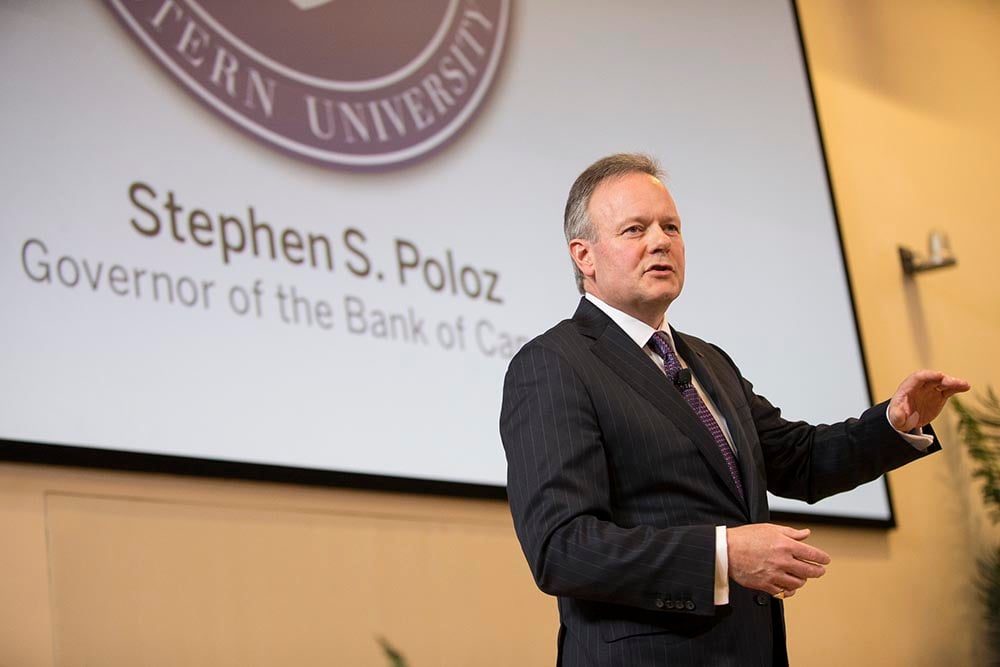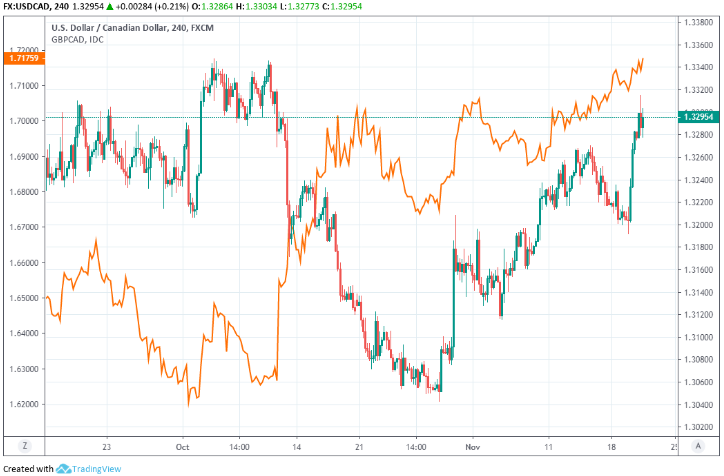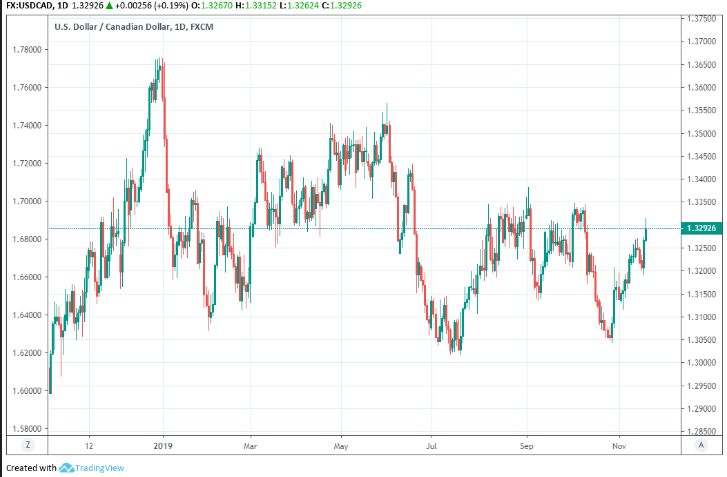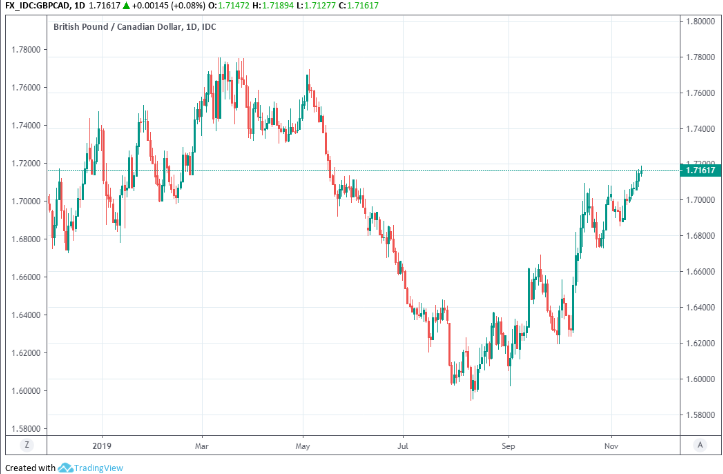Canadian Dollar Rescued by Near-target Inflation but Beware, the BoC is Turning
- Written by: James Skinner

Image © Pavel Ignatov, Adobe Stock
- CAD rescued from month-long lows Vs GBP and USD.
- After inflation remains near the BoC's target in October.
- But Wilkins' speech further evidence of BoC eyeing cut.
- Market still unprepared for BoC cut before June 2020.
- Pricing-in of lower rates could lift USD/CAD, GBP/CAD.
The Canadian Dollar was rescued from month-long lows Wednesday by near-target inflation figures for the month of October but the Loonie will be vulnerable to the U.S. Dollar and Pound Sterling in the weeks ahead because the Bank of Canada (BoC) is edging closer to cutting its cash rate.
Canadian inflation rose 0.3% in October, in line with the market consensus, which kept the annualised rate of price growth steady at 1.9%. Meanwhile, once gasoline was excluded from the goods basket, inflation rose by 2.3% last month after dropping 10 basis points from September's level.
The BoC's various measures of core inflation, which are thought to provide a better reflection of underlying trends by eliminating the most volatile items from the goods basket, all continued to average the 2% target last month.
Canada's Dollar retreated from a November low against the U.S. greenback and Sterling in response to the figures although neither move was sustained for long.
"If there's one thing that isn't keeping Governor Poloz up at night, it's inflation which again came in on both the headline and core measures almost bang on the Bank of Canada's 2% target," says Royce Mendes, an economist at CIBC Capital Markets. "The Bank of Canada will be more attuned to growth indicators rather than any wiggles in inflation when determining whether a rate cut is warranted in the months to come."

Above: USD/CAD rate shown at 4-hour intervals alongside Pound-to-Canadian-Dollar rate (orange line, left axis).
Markets care about inflation data because it's exactly these price pressures the BoC is attempting to manipulate with its interest rate policy, with hikes to the cash rate being deployed to ensure the consumer price index does not deviate meaningfully above the target while cuts to the benchmark for borrowing costs are used to ensure the price index doesn't fall too far below the target in subsequent years. Inflation is sensitive to growth and many other things.
Thursday's data comes hard on the heels of a speech from Carolyn Wilkins, the BoC's deputy governor, who told the International Finance Club of Montréal that "you want to put the winter tires on before the snow falls. It not only protects you, but also everyone else who’s on the road." The remark was widely interpreted as a hint that she'd rather cut the cash rate before the nascent global slowdown arrives on Canadian shores, instead of waiting until after.
"For once in a "blue moon", it's actually been an active morning in London for the CAD. The immediate catalysts appear to have been the "dovish" remarks from BoC's Wilkins yesterday afternoon and a squeeze on existing CAD long positions," says Stephen Gallo, European head of FX strategy at BMO Capital Markets. "A close above 1.3310 in USDCAD could be short-term bullish."
Wilkins said during her address that Canada's economy is in a good place but that the global economy is "facing immense challenges" including the U.S.-China trade war, which risks flaring again into year-end. She also told her audience at the club that Canada has plenty of tools at its disposal to fight an economic downturn with including "large-scale asset purchases," which is widely seen as a byword for a currency-crushing 'quantitative easing' program.

Above: USD/CAD rate shown at daily intervals.
"Boy...are they getting cautious at the Bank of Canada! This is not what the USDCAD fund short position wanted to hear in our opinion, and so we’d posit some of the screeching rally up to the 1.3260s yesterday was this crowd “throwing in the towel”. Yesterday’s NY close was very bullish, technically speaking," says Eric Bregar, head of FX strategy at Exchange Bank of Canada. "We think USDCAD buyers need to confidently show up now on any dips down to the 1.3270s if they are to respect yesterday’s bullish upside breakout. A NY close below this level would be hugely disappointing."
The BoC has bucked the trend among its peers this year, leaving its rate unchanged at 1.75% even as the Federal Reserve and others cut in order to fend off the disinflationary global slowdown. It signalled in October that it could soon cut rates but markets have not yet taken it seriously. The overnight-index-swap market implied Wednesday, a January 22 cash rate of 1.6%, down from 1.63% on Tuesday but still above the 1.5% that'll prevail after a cut.
"Still, to get significantly beyond the 1.3380 area in USDCAD (multi-month high), we’ll likely need a broadly stronger US dollar and a deterioration in risk sentiment," says John Hardy, chief FX strategist at Saxo Bank.
The BoC said last month it will monitor the extent that the slowdown spreads beyond the manufacturing and business investment fields, with it paying particular attention to consumer and household spending, while considering the most appropriate way forward on rates. This was after abandoning its oft repeated claim the current level of borrowing costs is "appropriate".

Above: Pound-to-Canadian-Dollar rate shown at daily intervals.
Canada's Dollar is the best performing major currency for 2019 off the back of the BoC's rate policy, which has its roots in the resilience of the domestic economy, although a change in that rate policy would put the Loonie's crown at risk. And such change, or losses for the Loonie, could well play out against an improved backdrop for Sterling.
"The 1.3000 level in the pound is pricing in a lot of optimism and the pound’s decline this week and failure to break that level recently on the back of Tory poll gains suggests that the market could be turning more cautious. We maintain our view that a Conservative majority in parliament would see the pound head quite deep into the 1.3000-1.3500 range. But a crucial 3 weeks still lies ahead for the pound," says Fritz Louw, a currency analyst at MUFG, of the GBP/USD rate.
The Pound has been boosted in recent months after Prime Minister Boris Johnson agreed terms of the UK's exit from the EU with Brussels and then secured the parliamentary support necessary for an election, which now offers scope for a Conservative Party majority government to lead an orderly EU exit. That's all-but eliminated the threat of a 'no deal' Brexit and might provide some semblance of certainty over trade at least until the end of 2020.
If weakness hits the Canadian Dollar at the same times as Sterling is recovering more of its earlier losses from other rivals, leading the USD/CAD rate to rise at the same time as the GBP/USD rate goes on the offensive, then the nascent upturn in the Pound-to-Canadian-Dollar exchange rate might endure for a while longer. However, that story might not play out until some time after the December 12 UK general election.
Time to move your money? Get 3-5% more currency than your bank would offer by using the services of a specialist foreign exchange specialist. A payments provider can deliver you an exchange rate closer to the real market rate than your bank would, thereby saving you substantial quantities of currency. Find out more here.
* Advertisement




